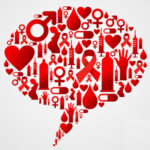Key Facts
- HIV tests are recommended for everyone.
- HIV tests may use blood or saliva.
- Make sure to get your results!

It’s now recommended that everyone over 13 years old should get tested for HIV at least once. If a young person is having sex without protection (e.g. not using condoms) has a new partner, has had STDs, or has other risks for getting HIV (such as IV drug use, or are men who have sex with men) he/she should get tested every 6-12 months. Ask your health care provider how often to get tested and whether you would consider taking PrEP (pre-exposure prophylaxis) medication to prevent HIV. Not everyone who is infected with HIV has symptoms or feels sick, so getting tested is the only way to know your status.
The number of new infections in young people (1 in 5 new infections are adolescents and young adults) makes it very important that everybody gets routine testing. Deciding to get tested can be the hardest part, so give yourself credit for taking a step to get tested. Testing is important to stay healthy and take are of your sexual health.
What is a test like?
There are many places to get HIV tests, such as your primary care provider’s office or a special testing site. You’ll first receive information about HIV, risk factors for HIV, and the types of different tests. You will have time to ask questions and talk about any concerns about getting tested. It’s your choice to get tested.
There are three main tests:
- Fourth Generation: The 4th generation test, is a type of blood test which takes about 3-5 days to get the results. This test is sensitive enough to detect HIV in your blood 2 weeks after a possible exposure. Offered almost everywhere.
- Rapid test (finger stick and oral tests):Both tests take about 20 minutes to get the results. This test will provide you with results 6 to 8 weeks after an exposure.
- Blood test is a finger stick; a small amount of blood is taken from the tip of the finger and mixed in a solution. There are both 4th and 3rd generation rapid tests.
- Oral test – a small amount of saliva from a person’s mouth is obtained using a cotton swab that looks like a toothbrush. You can buy this test at a pharmacy. We strongly encourage people to get tested in a clinic or at your primary care provider’s office for additional support and education.
- Confirmatory Testing (NATs) detect HIV the fastest by looking for HIV in the blood. It can take 7 to 28 days for NATs to detect HIV. This test is not as readily available (it’s often done by a lab if the Fourth-Generation test comes back reactive).
If any preliminary test is positive, the NAT blood test is done to confirm that the person is HIV positive.
It’s important to know there are three types of results that can come from a rapid test: invalid, non-reactive and reactive.
- An invalid result means that the test did not work properly and it will have to be repeated. (i.e. the test is expired).
- A non-reactive result means that no HIV antibodies were detected. Antibodies are your body’s response to a virus or infection. This would find any exposures which happened 6 weeks prior to the test or before that. A non-reactive test means that a person is HIV-negative.
- A reactive result is considered a preliminary positive, and means that HIV antibodies were found. A second test (NATs) needs to be done using blood drawn once from the arm, to confirm the first test’s result.
The third and last part of testing is getting your results and talking about what those results mean for the future. No matter which test a person chooses to do, it’s very important to always get your results!
Some testing sites, including Title X clinics, offer confidential testing. All the information is private. Only the testing provider is able to see the result and only with your approval will the tester be able to share this result with your primary care provider if you so choose. In almost all situations, your HCPs should know about the HIV so you get the best care.
Anonymous testing doesn’t use your name. It uses code names or numbers in order to identify your test and results.
Different test sites as well as different states have their own rules. Find out if the test is free, and who will have access to the results before you go to get tested.
Where Can I Get Tested?
You can get tested at your primary care provider’s office or at a local testing center. If you live in the US, find a local testing center near you on the CDC HIV testing resource site. This site has a feature where you can type in your zip code, and get the names and addresses of testing locations near you. It’s sponsored by the Centers for Disease Control and Prevention (CDC).
Our health guides are developed through a systematic, rigorous process to ensure accuracy, reliability, and trustworthiness. Written and reviewed by experienced healthcare clinicians from Boston Children's Hospital, a Harvard Medical School teaching hospital and consistently ranked as a top hospital by Newsweek and U.S. News & World Report, these guides combine clinical expertise, specialized knowledge, and evidence-based medicine. We also incorporate research and best practices from authoritative sources such as the CDC, NIH, PubMed, top medical journals, and UpToDate.com. Clinical specialists and subject matter experts review and edit each guide, reinforcing our commitment to high-quality, factual, scientifically accurate health information for young people.


